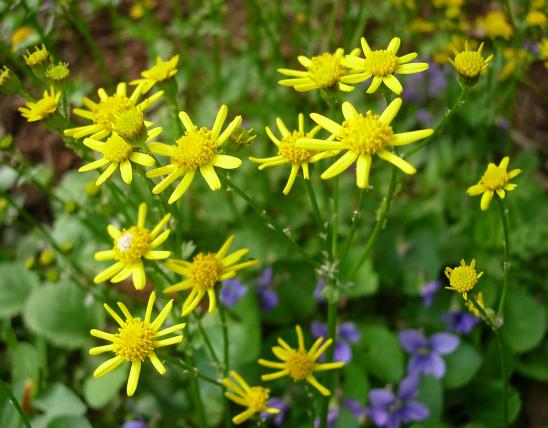
Tickseed sunflower is a much-branched annual or biennial. Hairless or with sparse hairs. Flowerheads daisylike, bright yellow, about 1¼ inches across, with usually 8 pointed ray florets. Bracts under flowerhead in 2 dissimilar rows; outer series spreading or reflexed, linear, not leaflike, with hairs along the margins; inner series lanceolate to narrowly ovate. Blooms August–October. Leaves opposite, pinnately (like a feather) deeply lobed or compound with 3–7 divisions, pointed, each with sharp teeth. Fruit flattened, black, with 2 needlelike awns that attach themselves to clothing and pets, thus the names “tickseed” and “beggar-ticks.”
Similar species: Eleven species of Bidens have been recorded in Missouri, plus 6 of the similar genus Coreopsis. Distinguishing among these species involves many anatomical features, including leaf characteristics, numbers of ray and disk florets, configuration of involucral bracts, and details of the fruits, right down to their barb-covered awns.
Common names of plants can be confusing; the name "sunflower" can technically apply to any of the thousands of species in the sunflower family, including species like this, in the genus Bidens. However, many people only consider members of genus Helianthus (which translates to "sunflower") as "true" sunflowers. For more on members of that genus, visit their group page.
Height: usually to 3 feet, occasionally to 5 feet.

Scattered to common statewide.
Habitat and Conservation
Occurs in bottomland prairies, upland prairies, bottomland forests, margins of ponds and lakes, sloughs, and fens; also crop fields, fallow fields, railroads, roadsides, and open, disturbed areas. Often grows in massive displays in moist bottomlands. Although this species is in the sunflower family, it is not in the same genus as true sunflowers (Helianthus).
Status
As their common names suggest, beggar-ticks (in the genus Bidens) are closely related to the genus Coreopsis (tickseed). Not only can it be difficult to tell the difference among species within each genus, but also it can be tricky even to separate the two genera. DNA analysis has shown that both genera are not natural units. As scientists unlock the genetic and ancestral relationships of these plants, be prepared for some regrouping and renaming of them in the future.
Human Connections
This species is sometimes grown by native wildflower and butterfly gardeners, but because it self-seeds abundantly it can become quite weedy. The seeds are an annoyance to hikers, who must pick them from pants and socks. Pets and livestock can also collect the seeds in their fur.
Ecosystem Connections
Birds and mammals eat the seeds, and many insects visit the flowers. By hitchhiking on the fur of animals, the seeds travel away from the parent plants. This reduces inbreeding and helps ensure that at least some offspring may find a suitable, safe environment in which to grow.









































